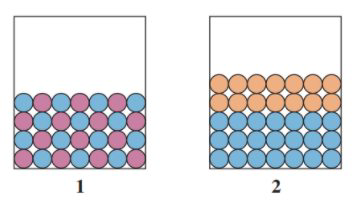
Concept explainers
The chapter sections to review are shown in parentheses at the end of each problem.
12.87 Match the diagrams with the following: (12.1)
a. a polar solute and a polar solvent
b. a nonpolar solute and a polar solvent
c. a nonpolar solute and a nonpolar solvent
 c
c
Interpretation:
The problem shows two diagrams with different type of solute-solvents.
Concept introduction:
- Like dissolves like is typically true between species
- Polar-polar solvents will always mix as well as Nonpolar-nonpolar solvents
- Nonpolar-Polar mixture will never mix, will form two phases.
To Match:The diagrams which shows the best option.
Answer to Problem 87UTC
Solution:
- 1
- 2
- 1
Explanation of Solution
There are different type of interaction between polar-polar, nonpolar-nonpolar and nonpolar-polar species. Therefore, one must ensure that the solute and solvent are well defined.
The solute is always in smaller amount than the solvent. Image (1) states an uniform mixture of species, whereas image (2) shows two phase, no mixture.
For any given mixture, there must be then either a polar-polar or a nonpolar-nonpolar solute/solvent system.
Image (2) shows the only combination possible, a nonpolar-polar mixture.
Always ensure to identify the solute, solvent and the type of interaction between them.
Want to see more full solutions like this?
Chapter 12 Solutions
Basic Chemistry
- The freezing point of acetic acid is 17.0 °C, and its Kf is 3.90 °C·kg/mol. If dissolving an amount of solute into 4.862 g of acetic acid results in a solution having a freezing point of 15.9 °C, how many moles of solute are in the solution?arrow_forwardDoes a polar solvent promote dissociatin of ionic solutes? A.More information is needed B. yes C.Noarrow_forwardWhat is the molarity of 50 grams H2SO4 in 1,500 ml solution? Mwt of H2SO4 is 98 g /molearrow_forward
- How many mL of a solution whose % (v/v) = 45% contain 30.0 mL of solute?arrow_forwardMost fish need at least 4 ppm dissolved O2 in water for survival. (a) What is this concentration in mol>L? (b) What partial pressure of O2 above water is needed to obtain 4 ppm O2 in water at 10 °C? (The Henry’s law constant for O2 at this temperature is 1.71 * 10-3 mol>L@atm.)arrow_forwardReagent nitric acid is 67.42% HNO3 by mass and its molarity is 13.35 M. Calculate its molality. Express final answer with two decimal places.arrow_forward
- What is the molar concentration of a نقطتان ( 2 solution that is 4 percent K2SO4 by weight and has specific gravity of * 1.03arrow_forwardToluene, c6h5ch3, is a liquid compound similar to benzene, c6h6. it is the starting material for other substances, including trinitrotoluene (tnt). find the molality of toluene in a solution that contains 35.6 g of toluene and 125 g of benzene.arrow_forwardA certain gaseous solute dissolves in water, evolving 12.0 kJ of heat. Its solubility at 25C and 4.00 atm is 0.0200 M. Would you expect the solubility to be greater or less than 0.0200 M at (a) 5C and 6 atm? (b) 50C and 2 atm? (b) 20C and 4 atm? (b) 25C and 1 atm?arrow_forward
- Dissolve 7.38 grams of potassium permanganate in sufficient quantity of water to make 1750 milliliters of solutions. The density of the solution is 2.7 g/ml. 1. What is the number of moles of the solvent? 2. What is the mole fraction of the solvent? 3. What is the a. molality, b. molarity, and c. normality? 4. What is the weight of solvent?arrow_forwardQuestion: A solution was prepared by dissolving 25 grams of fruit sugar in sufficient quantity of water to make 100 grams of solution. 1. What is the %W/W of the solution? 2. What is the molecular weight of the solute? 3. What is the mole of solute? Your answer here will be used for the next item(s). 4. What is the mole of solution? Your answer here will be used for the next item(s). 5. What is the mole percent of solute? 6. What is the molarity of the solution?arrow_forwardMost fish need at least 4 ppm dissolved O2 in water for survival.(a) What is this concentration in mol/L? (b) Whatpartial pressure of O2 above water is needed to obtain4 ppm O2 in water at 10 °C? (The Henry’s law constant forO2 at this temperature is 1.71 x 10-3 mol/L-atm.)arrow_forward
- Chemistry: Matter and ChangeChemistryISBN:9780078746376Author:Dinah Zike, Laurel Dingrando, Nicholas Hainen, Cheryl WistromPublisher:Glencoe/McGraw-Hill School Pub Co
 General Chemistry - Standalone book (MindTap Cour...ChemistryISBN:9781305580343Author:Steven D. Gammon, Ebbing, Darrell Ebbing, Steven D., Darrell; Gammon, Darrell Ebbing; Steven D. Gammon, Darrell D.; Gammon, Ebbing; Steven D. Gammon; DarrellPublisher:Cengage Learning
General Chemistry - Standalone book (MindTap Cour...ChemistryISBN:9781305580343Author:Steven D. Gammon, Ebbing, Darrell Ebbing, Steven D., Darrell; Gammon, Darrell Ebbing; Steven D. Gammon, Darrell D.; Gammon, Ebbing; Steven D. Gammon; DarrellPublisher:Cengage Learning Chemistry: Principles and ReactionsChemistryISBN:9781305079373Author:William L. Masterton, Cecile N. HurleyPublisher:Cengage Learning
Chemistry: Principles and ReactionsChemistryISBN:9781305079373Author:William L. Masterton, Cecile N. HurleyPublisher:Cengage Learning  Introductory Chemistry: An Active Learning Approa...ChemistryISBN:9781305079250Author:Mark S. Cracolice, Ed PetersPublisher:Cengage Learning
Introductory Chemistry: An Active Learning Approa...ChemistryISBN:9781305079250Author:Mark S. Cracolice, Ed PetersPublisher:Cengage Learning



